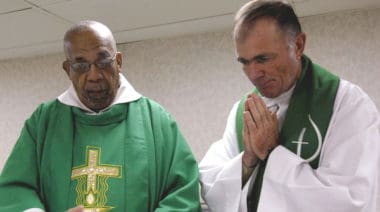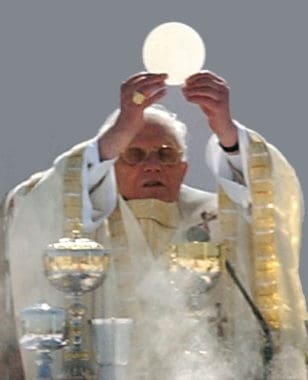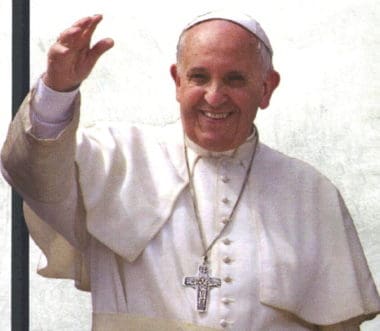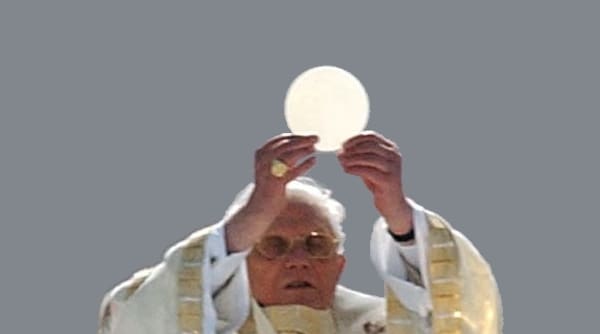Cult Cultivates Culture:
Culling Life’s Mysteries from the Liturgy
Liturgy’s Main Goals
“The glory of God,” says St. Irenaeus, “is man fully alive.” In this quote, the second-century saint sums up the two main goals of liturgy: God’s glory and man’s life. At the outset of its treatment on “The Celebration of the Christian Mystery,” the Catechism says that the Father “accomplishes the ‘mystery of  his will’ by giving his beloved Son and his Holy Spirit for the salvation of the world and for the glory of his name” (1066, emphasis added). The Church’s liturgy therefore manifests “the work of Christ the Lord in redeeming mankind and giving perfect glory to God” (1067, emphasis added). When we worship God, we come to life; and when we live life to the full—as saints—we honor God at the same time.
his will’ by giving his beloved Son and his Holy Spirit for the salvation of the world and for the glory of his name” (1066, emphasis added). The Church’s liturgy therefore manifests “the work of Christ the Lord in redeeming mankind and giving perfect glory to God” (1067, emphasis added). When we worship God, we come to life; and when we live life to the full—as saints—we honor God at the same time.
 Liturgy thus has everything to do with living in the world—life “out there,” outside of a church’s walls. Pope Benedict’s The Spirit of the Liturgy has “Liturgy and Life: The Place of Liturgy in Reality” as its opening chapter. Even though they exist as rituals directed by rubrics, our liturgical celebrations are meant to change the world. Liturgy animates creation decaying around us. Or, put another way, cult cultivates culture.
Liturgy thus has everything to do with living in the world—life “out there,” outside of a church’s walls. Pope Benedict’s The Spirit of the Liturgy has “Liturgy and Life: The Place of Liturgy in Reality” as its opening chapter. Even though they exist as rituals directed by rubrics, our liturgical celebrations are meant to change the world. Liturgy animates creation decaying around us. Or, put another way, cult cultivates culture.
How Cult Cultivates Culture
But to help us understand how worship animates our world—how cult cultivates culture—it’s worth the effort to understand just what is meant by “cult,” and then “culture,” and how the former “cultivates” the latter.
“Cult” may carry to our ears the aura of the eerie: hearing that one’s teenage daughter is a member of a cult is bad news. The primary sense of “cult,” though, denotes the relationship to the god or gods, one that is expressed in various words, actions, or rites. “Cult,” Pope Benedict explains, “exists in order to communicate this vision [of God] in such a way that glory is given to God” (The Spirit of the Liturgy, 18).
The relationship to God is not one that man himself can create, nor can he himself dictate the ways or means by which God wishes to be encountered. Rather, God himself comes to us and reveals how he wants us to relate to him: first at Mount Sinai in the giving of the Law, and then in person as the Incarnate Christ whose New Law inaugurates a new relationship: a new cult.
“Culture” can be as confusing a concept as “cult.” Many definitions and descriptions exist, among them Pope Benedict’s: “Culture is the social form of expression, as it has grown up in history, of those experiences and evaluations that have left their mark on a community and have shaped it” (Truth and Tolerance, 60). A culture, then, is the product of a group’s history, experiences, and values. Fourth-century Roman “culture,” for example, is the result of its fabulous founding by the brothers Romulus and Remus in 753 BC, followed by the centuries-long Republic and subsequent Empire after the two triumvirates. In this history emerge Roman values, such as industry, military power, conquest and management, agriculture, government. (The Gauls to the north, by contrast, had a different history than Rome and promoted different values: hence Gallican culture differed from Roman culture.)
Christianity, too, is founded on a particular history and set of values. When Christian culture encountered Roman culture through the leadership of Constantine—an instance of what today is called “inculturation”—both cultures changed, and mostly for the better. Christianity took up everything good in the Roman culture while purifying and elevating it according to the norms of Christian life and worship.
Liturgist Aidan Kavanagh adds another important insight to our appreciation of culture. Not only is a culture (or, by extension, a family, a group, or any other body) a product of history and values, but these are enacted, that is, performed in some ritual way. Thus, a culture is not only about ideas but also about actions. This summer, for example, Americans will observe the date July 4. When celebrated right, the day recalls our country’s history and values: George Washington, the Declaration of Independence, individual rights and freedoms, equality. But if the day were just about these things, July 4 would be a purely academic experience. So, added to our history and values are actions that embody and represent them: the coloring of things in shades of red, white, and blue; the scheduling of parades, fireworks, and gatherings of family and friends; the consumption of beer, burgers, and bratwurst normally reserved only for weekends. But were July 4 only about these latter doings—if the values and history they are meant to express are absent—then the day becomes meaningless. Our country’s citizens who participate well in authentic July 4 activities will be more American on July 5 than they were on July 3. A group’s thinking and doing yields, produces, animates, and cultivates its culture.
 See if Fr. Kavanagh’s description of culture applies in this instance: in Pope Francis’s recent letter on holiness, [Apostolic Exhortation] Gaudete et Exsultate, the Pope speaks of a “culture of zapping” (167). I had not heard of a “culture of zapping” before reading his letter. Still, could we begin to speculate what those living in such a culture think and do, what they value and how they act? This culture, as the Holy Father suggests, sees contemporary life’s many actions and distractions as “valid and good.” And how is the value of incessant distraction actualized? “We can navigate simultaneously on two or more screens and interact at the same time with two or three virtual scenarios.” To value distraction and to enact it by juggling devices yields a bitter harvest—one zapped (not to mention sapped) of life.
See if Fr. Kavanagh’s description of culture applies in this instance: in Pope Francis’s recent letter on holiness, [Apostolic Exhortation] Gaudete et Exsultate, the Pope speaks of a “culture of zapping” (167). I had not heard of a “culture of zapping” before reading his letter. Still, could we begin to speculate what those living in such a culture think and do, what they value and how they act? This culture, as the Holy Father suggests, sees contemporary life’s many actions and distractions as “valid and good.” And how is the value of incessant distraction actualized? “We can navigate simultaneously on two or more screens and interact at the same time with two or three virtual scenarios.” To value distraction and to enact it by juggling devices yields a bitter harvest—one zapped (not to mention sapped) of life.
In short, “cult” is the relationship we have with God. “Culture” is the expression of how we think and what we do. But what is the relation between the two? How does cult cultivate culture?
- First, stemming from Pope Benedict’s explanation of cult as our relationship to God, our faith clearly and emphatically teaches that this life-giving relationship demands corresponding relationships with others: neighbor, spouse, children, the environment, and even ourselves. “This split between the faith which many profess,” the Second Vatican Council says, “and their daily lives deserves to be counted among the more serious errors of our age” (Gaudium et Spes, 43). As Pope Benedict observed about the Old Law given at Sinai, “the people receive not only instructions about worship [i.e., “cult”], but also an all-embracing rule of law and life” (The Spirit of the Liturgy, 18). For us today, cult “seen in its true breadth and depth, goes beyond the action of the liturgy. Ultimately, it embraces the ordering of the whole of human life”—where man becomes “fully alive,” as St. Irenaeus put it.
- Second, given what Fr. Kavanagh observes about a culture’s foundation on both values and actions, it is clear that the liturgy forms us in both thinking and doing. Liturgical prayer proclaims sacred scripture—stories of sacred history, events, and persons revealing God’s own values, such as life, sacrifice, humility. But we don’t just receive revealed wisdom, divine-book learning. Rather, the Wisdom God reveals is incarnate and ritualized. His saving action is carried out and made present in sacramental action.
 The liturgy is often likened to a school or even a womb, where our Mother teaches and forms us according to supernatural values and divine works. Having been formed by her, she sends her children out into the world to animate it, her cult cultivating a culture based upon the Word and his saving sacramental work.
The liturgy is often likened to a school or even a womb, where our Mother teaches and forms us according to supernatural values and divine works. Having been formed by her, she sends her children out into the world to animate it, her cult cultivating a culture based upon the Word and his saving sacramental work.
Liturgical worship exists as ritual. And in this ritual, we are giving God glory and, in turn, we are able to animate all aspects of life. Such a liturgical ritual is not a dead, unthinking process. Rather, it is a breathing, organic unfolding of God’s mysteries to the world. Our worship (cult) breathes life (cultivates) into our surrounding world (culture).
 Editor’s Note: Christopher Carstens and Dan Burke will be discussing this article and taking your questions in a special Facebook Live Stream: Thursday, May 3 from 5-6 PM CENTRAL TIME. Join us, and follow the Avila Institute Facebook page for more great content. You may also click here to access it: https://www.facebook.com/AvilaInstitute/ If, by chance, you missed the Facebook Live Stream, you can still listen to, and view, the show by clicking here. It has been recorded for your benefit.
Editor’s Note: Christopher Carstens and Dan Burke will be discussing this article and taking your questions in a special Facebook Live Stream: Thursday, May 3 from 5-6 PM CENTRAL TIME. Join us, and follow the Avila Institute Facebook page for more great content. You may also click here to access it: https://www.facebook.com/AvilaInstitute/ If, by chance, you missed the Facebook Live Stream, you can still listen to, and view, the show by clicking here. It has been recorded for your benefit.
You can meet Christopher Carstens in person! He will be one of the speakers at this summer’s Avila Summit 2018. Won’t you join him?
+
Art for this post on cult cultivating culture: PORT-OF-SPAIN, Trinidad and Tobago (Sept. 21, 2007) – Father Joseph Harris, left, a Roman Catholic priest in Trinidad and Tobago, celebrates mass with Lt. Cmdr. Paul Evers, a Navy chaplain and Roman Catholic priest, aboard Military Sealift Command hospital ship USNS Comfort (T-AH 20), U.S. Navy photo taken by Mass Communication Specialist 2nd Class Joan E. Kretschmer, 21 September 2007, PD-US work of the U.S. federal government; Detail from Canonization ceremony of Brazilian Friar Frei Galvão celebrated by Pope Benedict XVI at the Campo de Marte, in Sao Paulo, Brazil, Fabio Pozzebom/ABr, 11 May 2007, CCA 3.0 Brazil; Modified detail of Stamps of Ecuador, 2015 [Pope Francis], Post of Ecuador, 2015, PD stamps of Ecuador; Missale Romanum, photographed by Lima, 24 September 2006, CCA-SA 2.5 Generic; all Wikimedia Commons. Avila Summit 2018 Logo, copyright Avila Foundation, Avila Summit, and Avila Institutes, all rights reserved.




